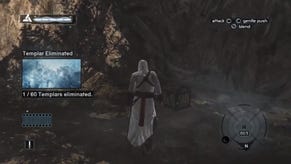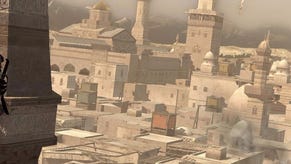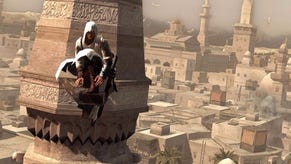Assassin's Creed
Getting away with murder.
Obviously we're not going to tell you anything. Ubisoft has worked hard to make sure that you're not only excited about playing Assassin's Creed, but that you're also dying to find out what's going on. What are all those glitchy graphical effects in aid of? Are you really in the Third Crusade at all? You want to find out for yourself, so go ahead.
What goes on in the Third Crusade is fair game though - and a fairly good game. Taking on the role of Altair, a quickly disgraced mega-assassin who doesn't respect his elders, you're given the chance to restore your name and rank by killing a sequence of increasingly naughty men scattered across the Holy Land in Damascus, Jerusalem and Acre - the three sprawling cities that host most of the game's running, jumping and assassering.
The two most arresting things about this are the astonishing graphics - more dazzling even than BioShock's, largely thanks to brilliant use of light and shadow - and the Canadian developer's unmatched interpretation of parkour, the art of "free running". As you approach a building, you can run up the wall and grab a small ledge, and then feel around for additional hand-holds, using the analogue stick to crawl up the side like Spider-Man. You can also bound across rafters, swing from beams and combine these actions, and while it's not quite limitless - there are plenty of times you'll wonder why you can't scale something - it puts even the silky platforming of Tomb Raider: Anniversary to shame as you dance beautiful, flowing escape routes across the tops of buildings.
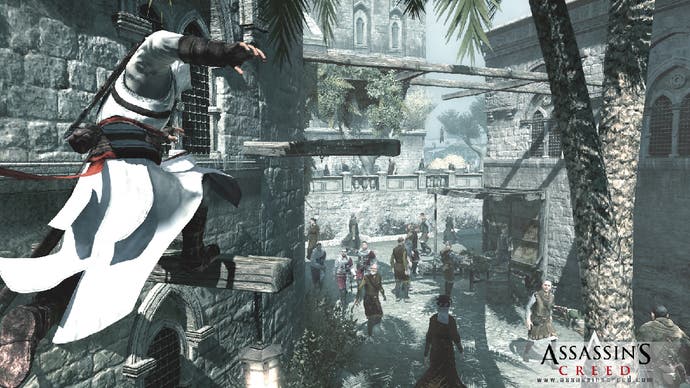
With nine main targets to kill across the span of the game, a lot of the time you spend in the Third Crusade is given over to information-gathering - eavesdropping on conversations, pick-pocketing messengers, interrogating, and tracking down informers - but despite Altair's fancy smock and bossy tone, he has to go and find them first, and to do this he climbs tall buildings. The "viewpoints" he reaches are a bit like Crackdown's Agency Supply Points - elevated positions that give you an overview of the surrounding area, and sometimes require a bit of skill to get to. Even when they're not, though, you find yourself drawn to them anyway, if only for the view.
Staring out across any of the game's cities, the largely optional Kingdom hub area that divides them, or from the peak of your Order's home city of Masyaf, crowned by a castle on a mountain, it's hard to catch your breath. The game drops barely a frame as Altair crouches - his gown dangling from his hooded head to give the impression of an eagle perched on a beam - and stares out over a sea of flat-roofed shanties, town houses, mosques and forts. And later the actual sea with boats in it. When you've "synchronised" to acquire mission data, you can leap headfirst into a hay-cart far below - something you can also do wherever you find pigeons congregating on the edge of a rooftop.
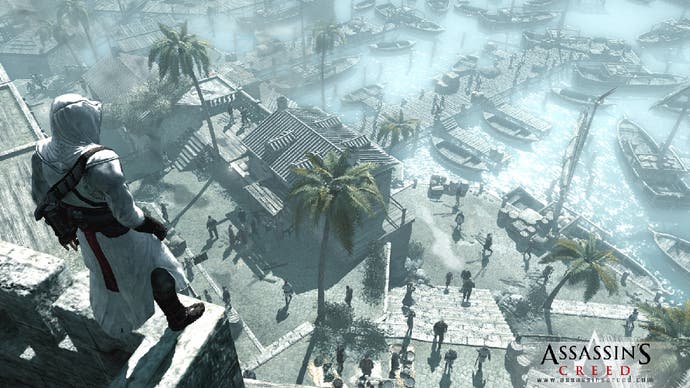
As a spectacle, Assassin's Creed remains convincing whether you're atop the highest building or sprinting down the narrowest street. Much has been made of the crowd technology (producer Jade Raymond called it "one of the promises of the next generation"), which treats non-player characters as proper, physical people with their own routines and attitudes to your behaviour. This manifests itself most obviously when you do something high profile, like climbing a building, and a chorus of quirky onlookers questions your sanity, but it's equally true that barging into them sows discontent and eventually puts the city guards on your case.
The controls are peculiar, but work very well in general. Altair is set up as a sort of marionette (cue additional intrigue) with feet, hands and head mapped across the face buttons, while left trigger locks on and off of targets and holding the right trigger modifies the function of the face buttons to "high profile" actions. This allows for a degree of adaptability in your attempts to remain unseen in crowds or evade angry city guards. Holding A on its own reduces Altair's visibility by having him pretend to be a monk as he walks at a very slow pace, but holding A with the right trigger down makes him sprint. The fact that holding the right trigger locks Altair to movement across low walls and other parkour elements as he moves can be disruptive, but you learn to work around it.



